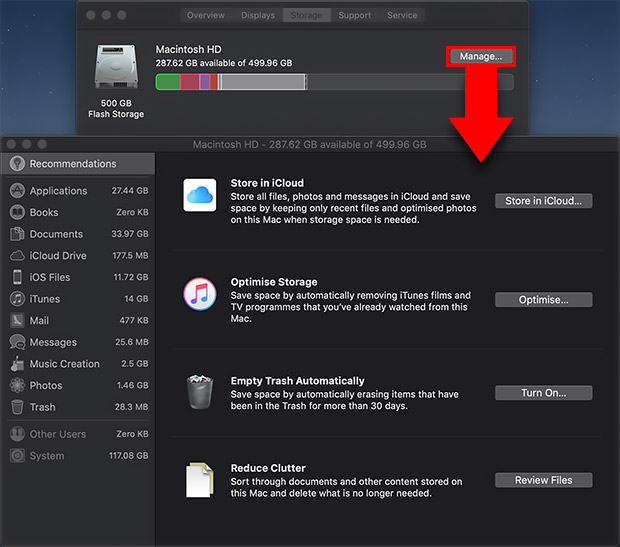How Much Free Space On Mac
/Mac Cleaner /iCloud Drive Taking Up Space on Mac: How to Clear?
- How Much Free Space On Microsoft Onedrive
- Free Space Platform
- How To Find How Much Free Space On Mac
- How To Find Out How Much Free Space On Mac
- How To See How Much Free Space On Mac
Open the Apple menu, then select About This Mac. Click the Storage tab in the toolbar to see how much disk space you have available. (On OS X Mountain Lion or Mavericks, click the More info. Click on the “Apple menu” and select About this Mac. Click the Storage tab and then select Manage - click on Mail in the left-hand sidebar. Underneath, you’ll find out how much space attachments are occupying, select and delete all attachments you no longer need.
How Much Free Space On Microsoft Onedrive
Here’s a question for you. Is your iCloud Drive taking up space on Mac? Of course, it is and it’s probably taking up more space than it should. Why is that so?
It could get pretty frustrating. In the first place, iCloud Drive taking up space on Mac shouldn’t even happen at all. If you have been saving almost all of your files to the iCloud drive, you should still have a good amount of space on your Mac, right? After all, you have been using the Optimize button to keep everything stored in the cloud and removed those purgeable files already.
Article GuidePart 1. Does iCloud Drive Use Mac Storage?Part 2. Why is iCloud Drive Taking up So Much Space on My Mac?Part 3. How Do I Clear Space on My iCloud Drive?Part 4. Conclusion
Part 1. Does iCloud Drive Use Mac Storage?
To understand if iCloud Drive uses Mac storage, imagine you have a MacBook and an iMac, which you have set up to use iCloud Drive. So, when you create a file on your iMac, it goes straight to Apple’s iCloud server. With a speedy internet connection, it should upload quickly.
After a few seconds, the same file is going to appear on your MacBook. It’s as if a copy has been put from one place to the other. Nonetheless, it’s pretty much the same file. If you make changes on the file on your MacBook, the changes will automatically be updated on your iMac as well and vice versa. It’s safe to say that the files are automatically synced in the three locations which are your MacBook, iMac, and Apple’s iCloud server. You don’t have to do anything to sync the file. As long as you have iCloud Drive turned on and you saved the file in iCloud Drive, it syncs automatically.
Now, let’s say that you created more files, some of which were pretty large. The new files you created will all sync to Apple’s iCloud server. They end up there first. Then they appear on your MacBook. Again, it will depend on how fast your internet connection is. Nonetheless, all the files will sync across and will be treated on your MacBook and your iMac as the same files.
The changes you make on one file will show up on the same file that’s located on the other machine. It’s the same thing if you delete a file. That same file will be deleted on the other machine as well. The reason for that is all the files are linked. Since all files are linked, it can eventually eat up a lot of space on the MacBook that doesn’t have a big capacity. So, how to deal with iCloud Drive taking up space on Mac issue? Before leaning the ways to gain more space on Mac, let's know why it is taking up space on Mac first.
Part 2. Why is iCloud Drive Taking up So Much Space on My Mac?
It could get pretty frustrating to find out that your iCloud Drive is taking up a lot of space on your Mac. All along, you thought that all your files are saved to the cloud especially with the Optimize Mac Storage feature enabled. So, you ask the same question again. Why is iCloud Drive taking up space on Mac?
What the Optimize Mac Storage does is that it, sort of, blocks your Mac from having a copy of every single file. Picture this. You’re filling up your iMac fast because of its huge hard drive capacity. Unfortunately, it’s not the same as your MacBook. It just doesn’t have as much space as your iMac. So, it’s running out of space fast. That’s where the Optimize Mac Storage comes in.
If you turn on the Optimize Mac Storage, it chooses the files that are saved on to your MacBook. If there’s a huge file that’s saved to iCloud Drive, you will just see the file name on your MacBook but it’s going to be empty. if you want to open it, you click on it and the file will be downloaded from the iCloud Drive. Again, you would need an internet connection to be able to open it. Take note that once you access the file, it goes right into the hard drive of your MacBook. Hence, it’s going to occupy space.

If macOS notices that you don’t use the file anymore, it will send it back to Apple’s iCloud Server. That could free up space on your MacBook. Keep in mind that the macOS can decide to get rid of files in both locations (your iMac and MacBook) if you have your Optimize Mac Storage turned on in both places. So, it’s safe to say that the reason why your iCloud Drive is taking up space on your Mac is that you’re frequently accessing the huge files from Apple’s iCloud server.
Should I Turn off iCloud Drive on My Mac?
iCloud Drive is usually very useful. Its main function is to automatically synchronize and copy files between devices, allowing you to easily share files between your own devices, so if you no longer need to use this feature, you can disable iCloud Drive on Mac.
Part 3. How Do I Clear Space on My iCloud Drive?
There are two easy ways for you to fix iCloud Drive taking up space on Mac issue. Read on to learn more about these two easy ways.
Option #1. Enable the Optimize Mac Storage
As previously mentioned, the Optimize Mac Storage can help limit the files saved on the Mac. To enable this feature, follow the steps below.
Step 1. Click on the System Preferences
Select and click on System Preferences from the drop-down menu. You will be taken to the System Preferences window.
Step 2. Look for iCloud
Now that you’re inside the System Preferences window, scroll down and look for iCloud. Click on it once you have found it. You will be taken to the iCloud folder.
Step 3. Adjust iCloud Settings
Click on the Options button you see opposite iCloud Drive. Scroll down and look for Optimize Mac Storage. Make sure the box is checked. There is a Done button on the lower, right-hand of the screen. Click on it to enable the Optimize mac Storage feature.
Option #2. Fix iCloud Drive Taking Up Space on Mac with PowerMyMac

The iMyMac PowerMyMac is also worth looking into especially if you are always accessing all your files from Apple’s iCloud server. The good thing about the PowerMyMac is that it erases large and duplicate files saved on to your Mac. So, even if you regularly access these files from Apple’s iCloud server, you won’t run out of space on your Mac. The steps below will show you how to use it.
- Download, install and launch the PowerMyMac on your Mac
- Choose files to Scan. If you want to delete large files, you can just click on the Large & Old Files.
- Allow PowerMyMac to run a scan by clicking the Scan button.
- Once PowerMyMac is done scanning your Mac, large and old files will appear on your screen. Select the ones you want to delete and click on the Clean button.
Part 4. Conclusion
The answer to your question of why is iCloud Drive taking up space on Mac is staring right into your face now. Take a good look at your Mac and see how many files you usually access from Apple’s iCloud server. If you’re accessing a lot, then your iCloud Drive could end up taking up space on Mac.
Free Space Platform
You can always enable Optimize Mac Storage in iCloud or you could use the iMyMac PowerMyMac. Truth be told, you can use both if you want.
Is your iCloud Drive taking up space on Mac? If yes, what are you going to do about it? Our readers would love to hear from you.
ExcellentThanks for your rating.
Rating: 4.6 / 5 (based on 91 ratings)
People Also Read:
PowerMyMac
A powerful all-in-one App for Mac
Free DownloadHow To Find How Much Free Space On Mac
brian peters2021-08-27 23:37:37
Clear as mud!. I use icloud and find it is taking space on my mac. I want to have as much free space as possible on my mac and thought icloud would store the data and not on the mac. Still trying to find a simple explanation for a 'non-techie' person.
Paul Harding2021-08-10 13:39:36
Good article but the conclusion remains as we started, “iCloud Drive keeps my information in the cloud but takes as much space as the files I need to store.” Either way a new Mac with lots of storage still runs out of space way too quickly! A lose lose situation.
Clean up and speed up your Mac with ease
Free DownloadJun 27, 2021 9:46 AM
Etrecheck can help you identify background applications. Post your Etrecheck results to the communities to get assistance removing unnecessary background applications:


https://www.devontechnologies.com/apps/freeware EasyFind can locate files without the help of Spotlight's index both hidden and otherwise.
http://www.reggieashworth.com/appdelete.html AppDelete
is the uninstaller that when you drag and drop applications over its window, it can locate and remove all related files in safe mode (boot with the shift key).
How To Find Out How Much Free Space On Mac
Note: Symantec Endpoint protection has its own uninstaller, which you will need to contact Broadcom support to reset its security password if you forgot it to remove it. That's independent of the system password.
How To See How Much Free Space On Mac
Jun 27, 2021 9:46 AM